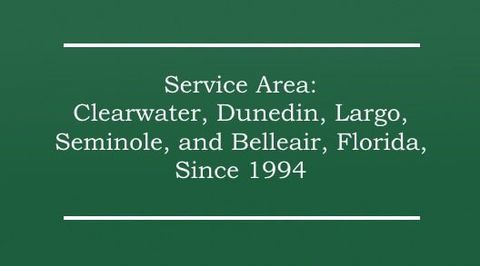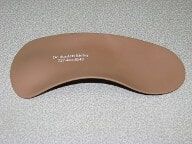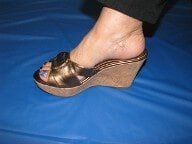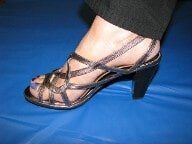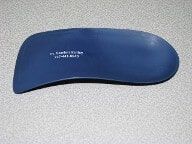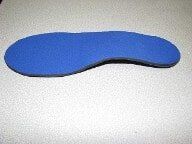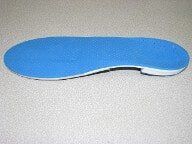Specialized Treatments
Specialized Treatment
Heel Pain Specialist
Dr. Kinley and her staff are dedicated to helping our patients get back to an active life-style as soon as possible and we have an effective protocol for achieving this goal.
Treatment plans combine relieving the pain from this condition as well as evaluating and treating the mechanical problems of the lower extremities that may be contributing to the heel pain syndrome. Orthotics
(arch supports) are often required to relieve and prevent reoccurrence of heel and arch pain. It's not uncommon for Orthotics to help relieve knee and back pain by re-aligning the feet and legs into a more correct position.
Dr. Kinley uses a combination of treatments to treat her patients, based on their overall health, activity level, and other specific factors. Treatment Options include:
- Cortisone injections (performed gently with topical anesthesia). This medication shrinks the bursa (sac of fluid under the heel) and is very effective in relieving the initial severe pain.
- Orthopedic taping to decrease the tension on the plantar fascia (tight band of tissue that becomes over-stretched, causing the painful bursitis under the heel, and eventually a heel spur)
- Anti-inflammatory medications when indicated
- Shoe gear modifications and recommendations
- Physical Therapy (at home or in Physical Therapy center if needed)
- Orthotics (arch supports)
In house, Same-Day Semi-Custom (Cost $ 149-169)
Surgery may be necessary for the rare cases which can't be resolved with the more conservative treatments. The procedure of choice for Dr. Kinley is called an Endoscopic Plantar Fasciotomy (EPF). In her Surgical Residency program, Dr. Kinley performed the original research for this minimally-traumatic surgery used to release the tight plantar fascia from the bottom of the heel using an endoscope (small camera) to get better visualization during the ligament release and avoid trauma to other structures. This procedure has a very high success rate and allow patients to put weight on the foot immediately. However, patients still must rest and avoid physical activities for 2-3 months.
Permanent Removal of Nail or Ingrown Nail Borders
by Chemical Matrixectomy, using Phenol and Alchohol (P&A)
This procedure is performed in the office with gentle local anesthesia to the base of the toe and Dr. Kinley uses special instruments designed specifically for the procedure. Permanent nail removal is used in the treatment of ingrown or Mycotic (fungus) toenails. After the section of nail is removed, the Phenol causes a chemical burn of the matrix (root) of the nail on the deformed or incurvated side or sometimes the entire nail bed. The alcohol is then used to neutralize the acid.
Chemical Matrixectomies are the preferred method of permanent nail removal performed by Dr. Kinley. Advantages include little to no post-operative discomfort for most patients as well as lack of disability after the procedure. Often, one can return to work the day after surgery, although an open-toe shoe may be necessary based on discomfort. Other advantages include no incisions and there is no post-operative scarring. A disadvantage of chemical matrixectomies is the healing time; however this procedure has the highest success rate (95-97%) in Dr. Kinley’s experience.
Partial nail removal with a chemical matrixectomy takes 3-5 weeks to heal.
Total nail removal can take 4-8 weeks to heal.
The process of healing is an inflammatory reaction from the chemical that causes the surgical area to drain. A rare complication of the procedure is recurrence of a nail spicule (sliver of nail that continues to grow). Sometimes the entire nail may be temporarily lost a few weeks after performing partial nail removal on both sides of the nail plate. This is especially true if the nail is already thick and very curved prior to the procedure. Formation of an abscess (or blocked drainage) also may occur after a matrixectomy. This occurs due to failure of the toe to drain. This is why post operative follow-up visits are very important.
Post-operative Wound Care (Your Choice, both are good):
Betadine Soak (2X Daily)
Soak your toe for 20 min. in Epsom Salt Water
Dry, Apply Betadine, Cover with Bandaid
Includes Betadine and Band-aids
One Toe: $7
Two Toes: $12
Amerigel Wound Care (1X Daily)
After bathing, apply Amerigel, Cover
with saline soaked gauze, Band-aid
Includes Amerigel, gauze, saline, Bandaids
One Toe: $40
Two Toes: $45
Surgical Fees
Insured Patients:
The majority of health Insurance Plans cover this procedure.
Non-Insured Cost:
$275 for 1st toe, 50% discount for each additional toe. This fee includes 3 post-op visits at 1 week, 3 weeks, 5-6 weeks.
Specialized Treatment
Heel Pain Specialist
Dr. Kinley and her staff are dedicated to helping our patients get back to an active life-style as soon as possible and we have an effective protocol for achieving this goal.
Treatment plans combine relieving the pain from this condition as well as evaluating and treating the mechanical problems of the lower extremities that may be contributing to the heel pain syndrome. Orthotics
(arch supports) are often required to relieve and prevent reoccurrence of heel and arch pain. It's not uncommon for Orthotics to help relieve knee and back pain by re-aligning the feet and legs into a more correct position.
Dr. Kinley uses a combination of treatments to treat her patients, based on their overall health, activity level, and other specific factors. Treatment Options include:
- Cortisone injections (performed gently with topical anesthesia). This medication shrinks the bursa (sac of fluid under the heel) and is very effective in relieving the initial severe pain.
- Orthopedic taping to decrease the tension on the plantar fascia (tight band of tissue that becomes over-stretched, causing the painful bursitis under the heel, and eventually a heel spur)
- Anti-inflammatory medications when indicated
- Shoe gear modifications and recommendations
- Physical Therapy (at home or in Physical Therapy center if needed)
- Orthotics (arch supports)
In house, Same-Day Semi-Custom (Cost $ 149-169)
Surgery may be necessary for the rare cases which can't be resolved with the more conservative treatments. The procedure of choice for Dr. Kinley is called an Endoscopic Plantar Fasciotomy (EPF). In her Surgical Residency program, Dr. Kinley performed the original research for this minimally-traumatic surgery used to release the tight plantar fascia from the bottom of the heel using an endoscope (small camera) to get better visualization during the ligament release and avoid trauma to other structures. This procedure has a very high success rate and allow patients to put weight on the foot immediately. However, patients still must rest and avoid physical activities for 2-3 months.
Permanent Removal of Nail or Ingrown Nail Borders
by Chemical Matrixectomy, using Phenol and Alchohol (P&A)
This procedure is performed in the office with gentle local anesthesia to the base of the toe and Dr. Kinley uses special instruments designed specifically for the procedure. Permanent nail removal is used in the treatment of ingrown or Mycotic (fungus) toenails. After the section of nail is removed, the Phenol causes a chemical burn of the matrix (root) of the nail on the deformed or incurvated side or sometimes the entire nail bed. The alcohol is then used to neutralize the acid.
Chemical Matrixectomies are the preferred method of permanent nail removal performed by Dr. Kinley. Advantages include little to no post-operative discomfort for most patients as well as lack of disability after the procedure. Often, one can return to work the day after surgery, although an open-toe shoe may be necessary based on discomfort. Other advantages include no incisions and there is no post-operative scarring. A disadvantage of chemical matrixectomies is the healing time; however this procedure has the highest success rate (95-97%) in Dr. Kinley’s experience.
Partial nail removal with a chemical matrixectomy takes 3-5 weeks to heal.
Total nail removal can take 4-8 weeks to heal.
The process of healing is an inflammatory reaction from the chemical that causes the surgical area to drain. A rare complication of the procedure is recurrence of a nail spicule (sliver of nail that continues to grow). Sometimes the entire nail may be temporarily lost a few weeks after performing partial nail removal on both sides of the nail plate. This is especially true if the nail is already thick and very curved prior to the procedure. Formation of an abscess (or blocked drainage) also may occur after a matrixectomy. This occurs due to failure of the toe to drain. This is why post operative follow-up visits are very important.
Post-operative Wound Care (Your Choice, both are good):
Betadine Soak (2X Daily)
Soak your toe for 20 min. in Epsom Salt Water
Dry, Apply Betadine, Cover with Bandaid
Includes Betadine and Band-aids
One Toe: $7
Two Toes: $12
Amerigel Wound Care (1X Daily)
After bathing, apply Amerigel, Cover
with saline soaked gauze, Band-aid
Includes Amerigel, gauze, saline, Bandaids
One Toe: $40
Two Toes: $45
Betadine Soak (2X Daily)
Soak your toe for 20 min. in Epsom Salt Water
Dry, Apply Betadine, Cover with Bandaid
Includes Betadine and Band-aids
One Toe: $7
Two Toes: $12
Amerigel Wound Care (1X Daily)
After bathing, apply Amerigel, Cover
with saline soaked gauze, Band-aid
Includes Amerigel, gauze, saline, Bandaids
One Toe: $40
Two Toes: $45
Surgical Fees
Insured Patients:
The majority of health Insurance Plans cover this procedure.
Non-Insured Cost:
$275 for 1st toe, 50% discount for each additional toe. This fee includes 3 post-op visits at 1 week, 3 weeks, 5-6 weeks.
Scarlett Kinley, D.P.M.
321 S Lincoln Avenue
Clearwater, FL 33756-5823
Scarlett Kinley, D.P.M.
321 S Lincoln Avenue
Clearwater, FL 33756-5823



Content, including images, displayed on this website is protected by copyright laws. Downloading, republication, retransmission or reproduction of content on this website is strictly prohibited. Terms of Use
| Privacy Policy
Scarlett Kinley, D.P.M.
321 S Lincoln Avenue
Clearwater, FL 33756-5823
Scarlett Kinley, D.P.M.
321 S Lincoln Avenue
Clearwater, FL 33756-5823
Phone:
(727) 441-8640
drscarlettkinley@gmail.com



Content, including images, displayed on this website is protected by copyright laws. Downloading, republication, retransmission or reproduction of content on this website is strictly prohibited. Terms of Use
| Privacy Policy

